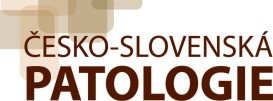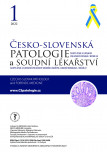 OFFICIAL WEBSITE OF THE JOURNAL OF THE CZECH AND SLOVAK SOCIETIES OF PATHOLOGY |
Instructions for Authors - Czecho-slovak pathology
Download:
Instructions for Authors ![]()
Template of the Manuscript Format ![]()
EndNote Citation Format File (ENS format)
The journal Česko-slovenská Patologie (Czech and Slovak Pathology; established in 1965; abbreviaton: Cesk Patol) supplemented independently by the journal Soudní Lékařství (Forensic Medicine, abbreviation: Soud Lek) is the official journal of the Czech and Slovak Societies of Pathology and of the Czech and Slovak Societies of Forensic Medicine and Toxicology. It is devoted to the publication of original studies in the field, case reports with novel observations and review articles. The journal publishes articles in English as well as in national languages (Czech, Slovak).
Beside the printed form, the original articles (incl. case reports) are published also on the website of the journal
(www.CSpatologie.cz) as Open Access articles with unrestricted online access to maximize their research and diagnostic impact.
An article is received with the understanding that it is submitted solely to this journal, and that no substantial portion of it has been submitted elsewhere. Manuscripts not prepared in accordance with the submission guidelines detailed below may be returned to the authors.
Standard Manuscript Form
All pages of the manuscript should be double-spaced and numbered (including references, tables and figure legends) using 12 point font (preferably Times New Roman) for all text, and with 2.5 cm margins throughout. Please refrain from using End Notes etc. as references or automatic list numbering because these features are lost in conversion: simply type the reference number in parentheses in the text and type the reference list. Formatting, such as Greek letters, italics, super-and subscripts, may be used: the coding scheme for such elements must be consistent throughout. Name your files with: “Name_Manuscript.doc”, “Name_FIG1.jpg”, etc.
Figures. Supply all figures electronically. Digital files TIFF or JPG (micrographs, photographs; minimum resolutions 300 dpi and at least 700 pixels (longer side) and EPS (graphs, annotated artwork; minimum resolution 800 dpi) are accepted. When preparing composite figures, prepare one file with composite figure and graphics (arrows, asterisks, etc.), but provide also separate files with the original source files and name the files appropriately (e.g. Name_Figure1A.jpg, Name_Figure1B.jpg, etc.). The composite figure will be prepared prior to the publication by our typographic designer according to your proposal.
Figures should be numbered in the order they are first mentioned in the text. Individual figure files should not exceed 10 MB. Do not include titles or captions within your illustrations.
Abbreviations should be avoided in the title and in Summary. Commonly-abbreviated terms should be spelled out in their first occurrence and then may be referenced in abbreviation through the remainder of the manuscript. Measurements, symbols and abbreviations should conform to SI Units.
Manuscript Preparation
Separate pages (but not separate files) should be used for the title page, summary and keywords, text, references, tables, figure legends. Number pages consecutively starting with the title page. Refer to tables and figures in the text, examples: (Fig. 1), (Tab. 1).
- 1. Title Page must include:
- Concise title accurately reflecting the findings of the work
- Names of all authors, e.g. John Smith, George Robert Davis
- Department, institution and address (city, country), where the research was performed
- For the different institutional affiliations use the superscript indexing, e.g. John Smith1, George Robert Davis2
- Name, address, phone, fax, and email of the corresponding author.
2. Summary and Keywords: The text must be preceded by a summary which should not exceed 300 words. The summary need not be structured into separate sections, should be prepared on a separate sheet and should be intelligible to the general reader without reference to the text. Underneath the summary, the author should give 3 to 6 keywords, preferably chosen from the medical subject headings (MeSH) in Index Medicus. Separate the keywords by hyphens.
The Czech/Slovak speaking authors should also provide (on the next separate page) the summary and keywords in their national language.
3. Text: start on a new page.
INTRODUCTION, MATERIALS AND METHODS, RESULTS, DISCUSSION, ACKNOWLEDGMENTS (in this order).
For Materials and Methods, aauthors should describe experimental and statistical methods in enough detail so that other researchers can replicate results and evaluate claims. When providing supplier information for materials sources, the company name should be provided. Website references to company information are not permitted. When appropriate, you can divide the section by subheadings (especially the Results and Discussion). The main headings are presented in full capitals, in a bold font (i.e., RESULTS). Subheadings are presented in a bold font (Subheadings A), lower level in italics + bold (Subheadings B) and the lowest level in italics (Subheadings C).
Acknowledgements of people, grants, funds, etc. should be placed in a separate section before the reference list. The names of funding organizations should be written in full.
4. References
Reference citations in the text should be identified by numbers in parentheses. Some examples: (3), (3,5), (1-5), (1-3,7) etc.
List of references (heading References) should begin on a new page, be double-spaced and numbered consecutively in order of citation in the text, including citations in tables and figure legends. Reference citations should not appear in titles or headings. Each reference must have an individual number. Always use the standard abbreviation of a journal’s name according to the Index Medicus. Please avoid excessive referencing. Personal communications and unpublished works should only be mentioned in the text. Do not use footnotes or endnotes as a substitute for a reference list. References with less than seven authors should list all names; for seven and more authors, list the first three names followed by et al.
References should conform to the style of the Journal. Sample references are given below:
- Journals:
- Galizia E, Giorgetti G, Piccinini G, et al. BRCA1 expression in triple negative sporadic breast cancers. Anal Quant Cytol Histol 2010; 32(1): 123-129.
Chapter in edited books:- Glinoer D. Thyroid disease during pregnancy. In: Braverman LE, Utiger RE, eds. Werner and Ingbar’s The Thyroid: A Fundamental and Clinical Text (8th ed). Philadelphia, PA: Lippincott Williams & Wilkins; 2000: 1013–1027.
Books:- Stevens A, Lowe J. Pathology (2nd edn). London: Mosby; 2000: 224–226.
Article in press:- Baselga J, Rothenberg ML, Tabernero J, Loretelli C, Bianchi F. TGF-ß1, pSMAD and TGFß-related markers in patients with advanced metastatic cancer. Proc Natl Acad Sci USA. In press 2011.
You can download EndNote Citation Format File
5. Tables
Tables should be typed double-spaced and submitted on separate pages, as part of the manuscript file. All tables are to be numbered using Arabic numerals and should always be cited in text in consecutive numerical order, example: (Tab. 1). For each table, please supply a table caption (title) explaining the components of the table. Give each column a short or abbreviated heading. Place explanatory matter in footnotes, not in the heading. Explain in footnotes all non-standard abbreviations that are used in each table. Be sure that each table is cited in the text.
6. Figure legends at the end of the main document. Each figure should have a concise caption describing accurately what the figure depicts. Figure legends should be submitted as part of the manuscript and should state the staining method and magnification. If the exact scale is critical, scale bars should be used on the photograph and specified in the legend. Figures should always be cited in text in consecutive numerical order, example: (Fig. 1).
Non-Native English Speakers: Authors who are not native speakers sometimes receive negative comments from referees or editors about the English-language usage in their manuscripts, and these problems can contribute to a decision to reject a paper. To help reduce the possibility of such problems, we strongly encourage such authors to have the manuscript reviewed before submission for clarity by a colleague whose native language is English.
- SUBMISSION ITEMS include a cover letter, the manuscript and figures.
All contributions should be submitted electronically via email to the Editor-in-Chief.
The cover letter (signed by the corresponding author) must include following statements: -
- that the manuscript, or parts of it, have not been and will not be submitted elsewhere for publication
- that the manuscript has been read and approved by all the authors, and that the requirements for authorship have been met
- statement of financial or other relationships that might lead to a conflict of interest. If no conflict exists, authors should state: The authors declare that they have no conflict of interest
- Where scanned signatures (in PDF file) cannot be provided in the electronic submission, authors may send a duplicate signed copy to the Editorial Office via the post or by courier. Without the signed cover letter, the manuscript will not be accepted for publication.
The Copyright Transfer Agreement must be signed by the authors before the manuscript is accepted for publication (it will be provided at the end of the review process).
for the journal "Česko slovenská Patologie (Czech and Slovak Pathology):
Ondřej Fabián, Assoc. Prof., M.D., M.D., Ph.D. - Editor-in-Chief
Clinical and Transplant Pathology Centre, IKEM, Prague, Czech Republic
Vídeňská 1958/9, 140 21 Prague 4, Czech Republic
Department of Pathology and Molecular Medicine, 3rd Medical Faculty, Charles University and Thomayer Hospital, Prague, Czech Republic
E-mail: editor@CSpatologie.cz
for the journal "Soudní Lékařství (Forensic Medicine):
Miroslav Hirt, Prof., M.D., Ph.D. - Editor-in-Chief
Dept. of Forensic Medicine, Tvrdého 2a,
662 99 Brno, Czech Republic
E-mail: hirt@fnusa.cz
Instructions for Authors - Soudní lékařství (Forensic medicine)
Link: Instructions for Authors in PDF format ![]()
SUBMISSION ADDRESSES:

Journal is published by Česká lékařská společnost J. E. Purkyně
Internet servis by Marek Uhrin, M.D., Entry to Intranet
